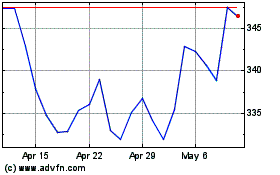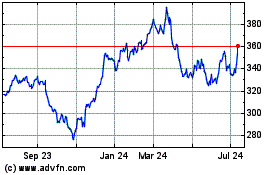By Theo Francis and Vipal Monga
U.S. companies are preparing to invest again after years on the
sidelines, and rising interest rates are unlikely to impede
them.
Executives have grown more optimistic about growth, in part
anticipating that President-elect Donald Trump's administration and
Republican congressional majorities will bring regulatory
rollbacks, corporate tax breaks and increased infrastructure
spending.
The Federal Reserve last month signaled interest rates would
rise at a faster pace than previously projected, showing increasing
optimism about the U.S. economy as it unanimously approved its
second rate increase in a decade.
Despite years of near-zero interest rates that made borrowing
cheap, many big U.S. corporations have been hoarding cash or
plowing money into safer pursuits in the wake of the recession.
Some, like General Motors Co. and railroad CSX Corp., borrowed to
prop up pension plans. Others, including Home Depot Inc. and Yum
Brands Inc., used cheap debt to repurchase shares. Meanwhile,
overall spending on building new factories or upgrading aging
equipment languished.
That is likely to change soon.
"We could be in store for a significant [capital-expenditure]
boom," said Charles Mulford, an accounting professor at Georgia
Institute of Technology in Atlanta.
Steel company Klöckner & Co., which generates about 40% of
its sales from its 50 sites in the U.S., expects to increase
spending on steel-shaping machinery here in the coming year. The
German company delayed such U.S. investments when demand slowed
from industrial customers that make everything from railcars to
storage tanks for oil producers.
Rising interest rates won't interfere with the planned
investments, said Gisbert Rühl, chairman of Klöckner's management
board. "If we have to pay 100 basis points more, that's not an
issue for us," Mr. Rühl said. "Even 200 basis points is not an
issue...It's still cheap." Fed officials have signaled that they
expect to raise rates by another 0.75 percentage point this year,
likely in three quarter-point moves.
The new optimism could mean the U.S. is poised to emerge from a
pattern that has frustrated the usual business investment cycle.
During downturns, businesses typically cut capital investment --
spending that increases or improves physical assets like buildings,
equipment and computers. As the economy picks up, they rapidly ramp
up spending, or risk being overtaken by more aggressive
competitors.
Business investment dropped sharply during the financial crisis,
falling more than 17% for S&P 500 companies in the 12 months
after Lehman Brothers' September 2008 collapse. But even as the
economy recovered, total expenditures took three years to regain
the precrisis level, according to data from S&P Dow Jones
Indices.
Companies saw little reason to invest when U.S. economic growth
was sluggish. Quarterly gross domestic product has averaged an
annualized 1.5% growth since the Lehman collapse, compared with a
decadeslong average -- going back to 1930 -- of more than 3%.
Another culprit was a resistance among corporate leaders to
lower the minimum rate of return on investment -- known as a hurdle
rate -- they would accept from new spending, largely out of fear of
disappointing shareholders.
"If returns are down and your hurdle rate hasn't changed, you'll
stop investing," said William Plummer, finance chief at
construction rental firm United Rentals Inc.
Instead, many businesses pursued safer alternatives. In 2015
alone, companies in the Russell 3000 index bought back nearly $700
billion of their own shares, the most since 2007, according to
research firm Birinyi Associates Inc. Last year through November,
those firms spent another $488 billion on buybacks.
Companies in the S&P 1500 pumped $550 billion into their
pensions between 2008 and Nov. 30 last year, according to Mercer
Investment Consulting LLC.
"Businesses simply haven't adjusted to a world of low interest
rates," said Paul Ashworth, chief North American economist for
Capital Economics Ltd., a research firm. "They're still looking for
5% or 6% returns, or 10% returns, on investment projects, and not
realizing the cost of borrowing is actually much lower."
Some companies continue to promise returns echoing those common
before the financial crisis. General Electric Co., for example, in
2016 tied pay for its executives to a 16% to 18% benchmark for
return on capital, in addition to measures of profitability and
growth in cash and earnings.
A GE spokeswoman said investors expect returns in that
range.
Many executives believed the Fed would raise interest rates
relatively soon after the recession ended, said Aldo Pagliari,
chief financial officer at toolmaker Snap-On Inc. That led
companies to put off lowering their estimates of what it would cost
to raise money to fund upgrades or new projects.
"If you look at 2009, 2010, or 2011, no one thought rates would
stay that low," he said. Snap-On now estimates cost of capital at
roughly 9.2%, down just slightly from the 10% it assumed before the
financial crisis.
In 2010, videogame retailer GameStop Corp. committed to spend
$300 million on share repurchases and $200 million on new stores
and other investments. The company had built up cash on its balance
sheet and executives felt they needed to return some to
shareholders in the absence of better alternatives. "The
interest-rate environment wasn't giving you anything for parked
cash," said Robert Lloyd, GameStop's finance chief.
More recently, the company has shifted tactics. GameStop has
boosted capital spending to roughly $160 million in 2016 from $125
million in 2013 for store refurbishments and expansion into new
categories like collectibles. Last year, it cut its buyback in
half. "It was the right thing for us to diversify the company and
make those investments," Mr. Lloyd said.
Write to Theo Francis at theo.francis@wsj.com and Vipal Monga at
vipal.monga@wsj.com
(END) Dow Jones Newswires
January 02, 2017 11:04 ET (16:04 GMT)
Copyright (c) 2017 Dow Jones & Company, Inc.
Home Depot (NYSE:HD)
Historical Stock Chart
From Mar 2024 to Apr 2024

Home Depot (NYSE:HD)
Historical Stock Chart
From Apr 2023 to Apr 2024
